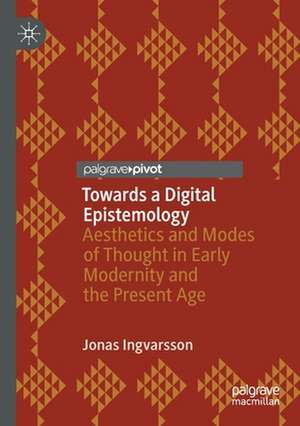Towards a Digital Epistemology: Aesthetics and Modes of Thought in Early Modernity and the Present Age
Autor Jonas Ingvarssonen Limba Engleză Paperback – 2 dec 2021
| Toate formatele și edițiile | Preț | Express |
|---|---|---|
| Paperback (1) | 379.48 lei 6-8 săpt. | |
| Springer International Publishing – 2 dec 2021 | 379.48 lei 6-8 săpt. | |
| Hardback (2) | 335.44 lei 38-44 zile | |
| Springer – 30 noi 2020 | 335.44 lei 38-44 zile | |
| Springer International Publishing – 2 sep 2021 | 417.90 lei 6-8 săpt. |
Preț: 379.48 lei
Nou
Puncte Express: 569
Preț estimativ în valută:
72.61€ • 75.82$ • 59.96£
72.61€ • 75.82$ • 59.96£
Carte tipărită la comandă
Livrare economică 15-29 aprilie
Preluare comenzi: 021 569.72.76
Specificații
ISBN-13: 9783030564278
ISBN-10: 3030564274
Pagini: 140
Ilustrații: XVI, 140 p. 10 illus.
Dimensiuni: 148 x 210 mm
Greutate: 0.21 kg
Ediția:1st ed. 2020
Editura: Springer International Publishing
Colecția Palgrave Macmillan
Locul publicării:Cham, Switzerland
ISBN-10: 3030564274
Pagini: 140
Ilustrații: XVI, 140 p. 10 illus.
Dimensiuni: 148 x 210 mm
Greutate: 0.21 kg
Ediția:1st ed. 2020
Editura: Springer International Publishing
Colecția Palgrave Macmillan
Locul publicării:Cham, Switzerland
Cuprins
1. Digital Epistemology - An Introduction.- 2. CCC Vs WWW: Digital Epistemology and Literary Text.- 3. Evoking McLuhan's Juxtapositions in the Digital Age: Archaeology and the Mosaic.- 4. "Books are Machines": Materiality and Agency from the 1960s to the 2010s.- 5. Towards a 21st Century Pedagogy for the Humanities.
Notă biografică
Jonas Ingvarsson is Senior Lecturer in Comparative Literature, Digital Humanities and Editorial Practices at the University of Gothenburg, Sweden. He is the author of books and articles on posthumanism and culture, media archaeology and digital epistemology. He is currently heading a research project on the history of literary criticism, combining discourse analysis with text mining and big data analysis.
Textul de pe ultima copertă
This book explores the concept of digital epistemology. In this context, the digital will not be understood as merely something that is linked to specific tools and objects, but rather as different modes of thought. For example, the digital within the humanities is not just databases and big data, topic modelling and speculative visualizations; nor are the objects limited to computer games, other electronic works, or to literature and art that explicitly relate to computerization or other digital aspects. In what way do digital tools and expressions in the 1960s differ to the ubiquitous systems of our time? What kind of artistic effects does this generate? Is the present theoretical fascination for materiality an effect or a reaction to a digitization? Above all: how can early modern forms such as the cabinets of curiosity, emblem books and the archival principle of pertinencecontribute to the analyses of contemporary digital forms?
Caracteristici
Presents the notion of digital epistemology Argues that early modern aesthetic practices can be productively related to expressions in digital culture Merges media archaeology with digital humanities research
